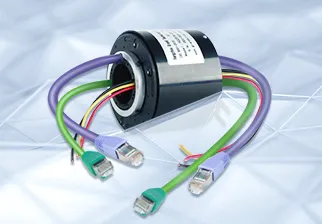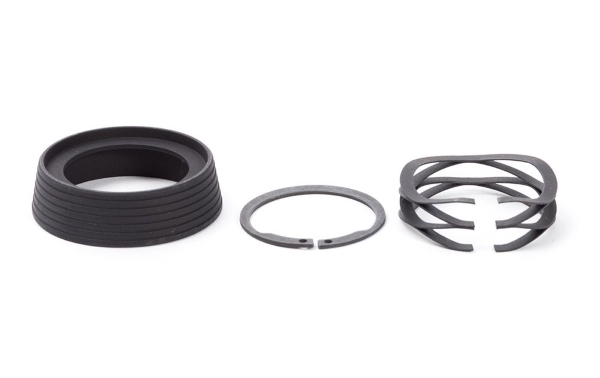Electricity, since its discovery, has been the driving force behind many of mankind’s greatest inventions and technological advancements. Essential to the operation of numerous electrical devices is the simple yet significant concept of transferring electrical power or data. In various industries – from electronics and telecommunications to aerospace and heavy machinery, the need for effective methods of transfer has led to the development of specialized components called electric rings. These components have been painstakingly engineered to provide reliable and efficient connections.
One of the most foundational elements for enabling such power or signal transfer in electromechanical systems is electric rings. Classified broadly, these ring devices are predominantly of two kinds: slip rings and delta rings. While both of these rings have specific purposes and unique functionalities, they share the common characteristic of making power or data transfer seamless and efficient, often in complex and demanding environments.
Slip rings, also known as rotary electrical interfaces, rotating electrical connectors, collectors, swivels, or electrical rotary joints, are devices that allow the transmission of power and electrical signals from a stationary part to a rotating part. On the other hand, delta rings are used in three-phase electrical systems where they allow the connection of electrical motors and transformers in a delta configuration, aiding stable electrical connections and efficient power transmissions.
In the subsequent sections of this article, we delve significantly deeper into the specifics of slip rings and delta rings, their working principles, application areas, and the distinguishing factors between the two. Armed with this knowledge, one could better understand the inherent value of these devices and make informed decisions on which type of ring would best service their specific requirements.
What Are Slip Rings
When it comes to transferring electrical power or signals from a stationary system to a rotating assembly, slip rings play an integral role. Essentially, a slip ring is a methodical device that’s designed to conduct electricity from a static entity to a part that’s undergoing rotation. It ensures a firm and continuous electrical connection while alleviating the usual hindrances of mechanical wear and resistance.
Peering into the general working principles of a slip ring reveals an elegant yet effective method of power transmission. The primary elements of a slip ring are concentric conductive rings and corresponding “brushes” that maintain physical contact with the respective rings. The conducting rings are connected to the rotating assembly (rotor), and the brushes, which slide along the rings as they rotate, are tethered to the stationary assembly (stator). Electrical power or signals are transferred across this rotor/stator interface via the brushes and rings, enabling communication or power delivery.
Given the plethora of applications where energy transmission between stationary and rotating parts is required, various types of slip rings have been developed with specialized functions and capabilities.
- Traditional carbon brush slip rings are the most common type, using a physical brush to ring connections to transfer power or signals.
- Mercury-wetted slip rings utilize a pool of mercury in which the contacts dip to achieve connection. These provide a high-quality connection with low resistance but are only usable in certain environments due to the mercury’s liquid state.
- Fiber-optic slip rings, also known as FORJs (Fiber Optic Rotary Joints), are designed for transmitting optical signals between the rotor and stator.
- Wireless slip rings, or inductive couplers, use magnetic fields for power and data transmission, eliminating the physical wear and tear that can occur in traditional slip ring designs.
The versatility and efficiency of slip rings have secured their position across a wide range of fields and industries. In the field of aerospace, slip rings are integral parts of radar systems and satellites, enabling the rotation of antennas while maintaining the flow of data signals. They are key to wind turbines, delivering the produced power from the rotating turbine to the stationary grid. Automation and manufacturing sectors utilize slip rings for rotary tables, packaging machines, and cable reels. Other applications include the use of automotive testing machines, video surveillance systems, and even some medical equipment. In essence, anywhere power or data transmission across a rotating interface is involved, there’s a high chance a slip ring contributes to the process.

Understanding Delta Rings
Thinking about the efficiency and stability of electrical connections in three-phase electrical systems, a unique component comes to mind—the delta ring. Essentially, a delta ring serves as a connectivity solution, primarily used for wiring electrical motors and transformers in a delta configuration. This configuration, often preferred for its reliability and seamless power transmission, allows a single failure in the system to not completely disrupt the whole circuit.
Unraveling the general working principles of a delta ring takes us to the foundations of three-phase electrical systems. A three-phase system consists of three individual electric circuits, each with its own alternating voltage waveform, all separated by a consistent time phase. Delta rings come into play to connect the ends of these three phases in a triangular shape emulating the Greek letter ‘delta’, hence the name. Each point of the triangle acts as an interface for an electrical connection, thus closing the loop in the system. The design allows for a continuous supply of power even if one phase drops off, reducing the risk of complete system failure.
Given variations in system designs and applications, there are different types of delta rings with specific functions:
- Solid delta rings are rings made of rigid materials, providing robust and reliable connections but can be tough to install due to their rigidity.
- Flexible or split delta rings, on the other hand, allow for more accessible installation since they can bend to fit varying motor or transformer configurations.
- Insulated delta rings are coated with an insulating material for added safety and enhanced protection against electrical shorts.
Delta rings find their applications in a wide range of fields and industries where stable power distribution and minimal disruption are crucial. A major application of delta rings is in power distribution networks, where energy drawn from power stations is distributed to households and businesses. Electrical transformers, which serve as the backbone of these networks, often use delta rings for their wiring configurations. Industrial motors found in water pumps, compressors, elevators, and other machinery are also commonly hardwired in a delta configuration using delta rings. They ensure smooth and continuous operation, helping industries stay productive by minimizing downtime caused by system disruptions.

Comparative Analysis: Slip Ring vs. Delta Ring
Essential elements in the world of electromechanics, slip rings, and delta rings, each serve unique purposes with their distinct designs and functionalities. While their operations may appear similar, they have different capabilities, varying applications, and specific benefits and drawbacks.
When we look at the comparison of designs and working principles:
- Slip rings operate on the principle of delivering power or electrical signals through brushes that maintain contact with rotating rings, creating a connection between the stationary and rotating parts.
- Delta rings, on the other hand, focus on connecting three phases of an electrical system in a closed-loop, triangular configuration. They ensure that power remains flowing even if one phase in the system fails.
With respect to types and variations available:
- Slip rings have multiple variations depending on their application. These include traditional carbon brush slip rings used across industries, mercury-wetted slip rings for environments where a high-quality connection is required, fiber-optic slip rings for optical signal transmission, and wireless slip rings or inductive couplers that use magnetic fields to eliminate mechanical wear.
- Delta rings typically come in three broad types: solid delta rings, flexible or split delta rings, and insulated delta rings, each offering different advantages in terms of stability, flexibility, and safety, respectively.

Comparing them in terms of application:
- Slip rings are more versatile and are used widely in any application involving a rotating interface, such as radar systems, wind turbines, rotary tables, cable reels, and more.
- Delta rings are specifically used for three-phase electrical systems, for example, in power distribution networks, electrical transformers, and industrial motors. Their application is more niche compared to slip rings.
Looking at user concerns and feedback such as durability, pricing, maintenance, and installation requirements:
- Slip rings can face wear and tear due to mechanical contact between the brushes and rings, which may lead to eventual replacement. Some of the advanced types of slip rings, like wireless or fiber-optic, can be quite expensive. Furthermore, slip rings need occasional maintenance to deal with brush wear or debris buildup and can be complex to install due to the many components involved.
- In contrast, delta rings generally last longer, as there’s less potential for mechanical wear. They are cheaper than most advanced slip rings, require less maintenance, and are easier to install, especially the flexible types.
In summary, both slip rings and delta rings offer unique benefits and tradeoffs. It’s important to consider these factors when deciding which one fits the best with your applications and objectives.

How to Choose Between Slip and Delta Rings
Choosing between slip rings and delta rings primarily comes down to the specific requirements of your project or application. Here, we’ll explore some of the key factors to consider and how to best decide which rings to select.
Determining factors for choosing one over the other often involves a detailed evaluation of the technical and operational requirements of your apparatus.
- Do you have a rotating assembly requiring continuous power or signal transmission? A slip ring would be the suitable choice here, fitted for transferring electricity or signals from a static system to a rotating part.
- Are you dealing with a three-phase electrical system demanding a seamless, uninterrupted power distribution even if one phase fails? This is where a delta ring comes to the rescue, ideal for connecting phases in a reliable delta configuration.
The importance of understanding the needs of the application or project can’t be overstated. When selecting the right component for your equipment, a clear understanding of your project needs, including the type of electrical system, the rotation requirements, the environment in which it’ll operate, and the available budget, will help guide you in the right direction.
Here, are some recommendations depending on various types of use cases:
- For applications like wind turbines, rotating display stands, cable reels, or video surveillance systems involving rotational motion and requiring continuous signal or power transmission, slip rings would be the best choice.
- For scenarios where you need a robust power distribution network with minimal disruptions like in industrial motors, transformers, and power distribution systems, a delta ring would serve you better.
In conclusion, selecting between slip rings and delta rings can be a crucial decision that influences the efficiency, reliability, and longevity of your system. A careful understanding of the technical requirements of your project or application is key to making an informed choice.
The Future of Slip Rings and Delta Rings
Electrical connectivity is a perpetually evolving field, fueled by ongoing technological advancements and increasing demands for efficient and reliable power transmission. As an integral part of this domain, slip and delta rings are also being transformed in line with this progression.
Let’s explore the latest technological advancements and future trends in these fields and how they might impact users and industries.
Innovative materials and designs in slip rings:
New materials aimed at enhancing transmission quality and reducing mechanical wear are being introduced to slip ring designs. For instance, rings made of precious metals are less prone to corrosion, provide better conductivity, and increase the lifespan of the components. Also, improvements in brush technology such as the use of advanced composite materials are helping reduce noise, electrical interference, and brush wear.
Wireless slip rings:
Looking at future trends, the development of wireless slip rings or rotary transformers is gaining traction. Utilizing magnetic induction to transfer power or signals, these devices eliminate the need for physical contact, significantly reducing wear and improving lifespan.
Advanced delta rings with better materials and added features:
Delta rings are also seeing improvements, mainly in terms of material quality and additional safety features. For instance, delta rings made from superior conductive materials are more efficient and robust, while those with extra insulation features provide enhanced safety measures.
These advancements and predicted changes could have significant impacts on users and industries.
Users may benefit from increased reliability and operational lifespan of their systems with these new and improved components. Industries hinging a lot on electrical connectivity such as power distribution, manufacturing, and electric vehicles might see a rise in overall efficiency and a reduction in downtime. Moreover, advanced slip rings can enable faster and more stable data transmission, significant for industries handling large volumes of data.
However, it’s worth noting that new technologies may bring higher costs of components and possibly more complexity in installation and maintenance. Therefore, it’s crucial for users and businesses to weigh these potentials against their specific needs and budget considerations.
In conclusion, as the future unfolds, slip and delta rings will likely continue adapting and innovating to serve the evolving needs of power transmission and electrical connectivity.
Conclusion
In summary, slip rings and delta rings serve distinct purposes and applications, with their unique designs and working principles catering to specific industries and devices. It is essential to choose the right type of ring for your particular needs, keeping in mind factors such as application requirements, durability, budget constraints, and installation complexity. Staying informed will lead to better decision-making when integrating these critical electrical components into your projects.
FAQs about Slip Ring Vs Delta Ring
Understanding technical components like slip rings and delta rings often involves a deeper understanding and resolution of frequent queries. Here, we address some popular questions related to these components and provide clear, concise answers to enhance your knowledge and understanding.
Q: What is the primary purpose of a slip ring?
A: A slip ring serves the key function of transmitting electrical power or signals from a stationary system to a rotating assembly. It ensures a continuous electrical connection, overcoming the challenges of mechanical wear and resistance.
Q: How does a delta ring function?
A: Delta rings are used in three-phase electrical systems, where they connect the ends of each phase in a triangular or ‘delta’ configuration. By doing so, they form a closed loop that allows power to keep flowing even if one phase fails.
Q: Can a slip ring and a delta ring be used in the same application?
A: While both assist in electrical connections, their applications are distinct. Slip rings are used where power or signals need to be transmitted between a stationary and rotating part, like in rotating machinery. Delta rings, however, are employed in three-phase power systems, like power distribution networks. It’s theoretically possible for an application to need both, but it would be rather unusual and specific.
Q: Which type of slip ring should I use for high-speed data transmission?
A: Fiber-optic slip rings, also known as Fiber Optic Rotary Joints (FORJs), are designed explicitly for transmitting optical signals. They are ideal for high-speed data transmission due to their capacity to handle optical signals without any loss in quality or speed.
Q: When would I use an insulated delta ring?
A: Insulated delta rings, coated with an insulating material, are used for safety reasons and to prevent short circuits. They are ideal for applications where the equipment is exposed to varying environmental conditions or where there is a risk of accidental contact with conductive parts.
Have questions about our slip ring products? Fill out the form and we will respond promptly.

